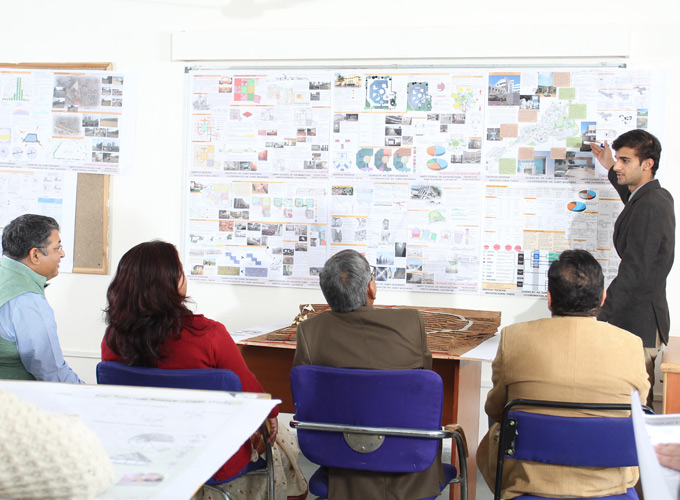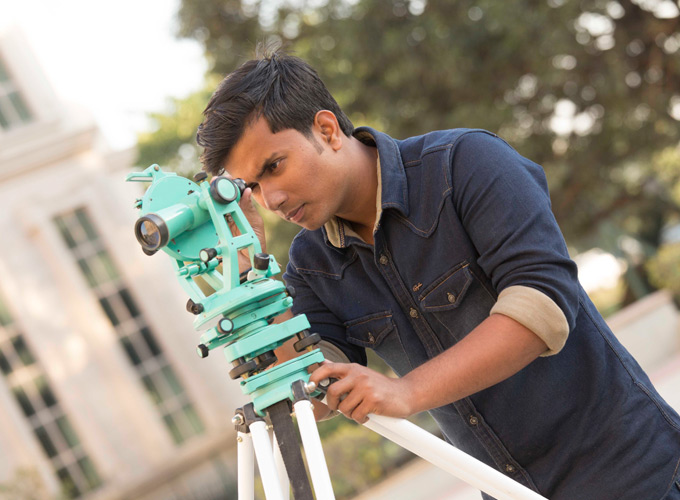The state-of-the-art infrastructure and facilities include a construction yard, model making room, climatology lab, and surveying lab, besides an exhibition room. These facilities have modern specialised equipment, and apparatus, and materials that help in imparting theory and practical applications to students of ASAP. The infrastructure provides various opportunities for hands-on training to gain insight into the fields of architecture, planning and construction. A well-equipped library, smart classrooms, lecture rooms, studio classes, and access to wi-fi are crucial academic elements in ASAP. The sound infrastructure of ASAP creates an academic environment that is student-friendly, aesthetically appealing, and environment-friendly.
Lab
Climatology Lab- The lab equips students of architecture and planning to quantify environmental changes with respect to urban dynamics. The lab has several equipments such as a hot air oven, hot plate, incubator, furnace, connectivity meter, compressor, analyzer, and a few instruments to measure temperature, wind speed, and heat flow in buildings. This state-of-the-art lab was also developed to test water, air, and soil. This facility is also relevant to various studio projects undertaken by students at undergraduate level. The lab is a powerhouse of innovative learning and hands-on experience. Students enhance learning through experiments and projects on relevant topics. The lab comprises of advanced instruments and infrastructure like rain gauge, anemometer, dry and wet thermometers, etc to help learn the details of climate responsive architecture through experiential learning.


Surveying Lab– This lab is equipped with various instruments and tools used by students for surveying. Students learn techniques for gathering field data by using both traditional and modern instruments. Students use a dedicated set of instruments used in surveying assignments and projects, including level rods, tripods, tape measures, chaining pins, and other common surveying tools, as well as ancillary equipment. This lab is vital to understanding the nuances of architecture and design. The hands-on training hones knowledge and practical skills in students of Architecture and Planning. The lab for surveying comprises all the instruments required to conduct field surveys for various sites identified for proposed developments.
Computer Centre at ASAPL is equipped with projector facility and software like AutoCad, 3DS Max, Sketch-up, Revit, Coral Draw, etc. installed to cater to the students' needs at the institute.
Material Lab The Building Material Lab comprises samples of most of the materials used for construction activity, i.e., samples of bricks, their types, specialised units, cement, aggregates, sand, plumbing tools and accessories, samples for interior finishes and fixings, etc. The lab is a comprehensive collection of samples of all the materials required during construction and finishing of projects to give the students hands-on experiential learning of the process.

Exhibition room
This facility displays selected creations and innovative projects of students in architecture and design elements. Students also showcase here the practical versions of theoretical knowledge as well as architecture and design fundamentals gained during the academic year.

Construction Yard
Students conduct hands-on activities on building construction planning and techniques. This facility provides an array of opportunities for students to experiment with different building materials, construction plans, and technology.
Student Activity Area and Model Making Room – In the world of architecture, interior design, landscape architecture, and town planning, models (or scale models) have been used to facilitate building and construction. Architects and draughtsmen create and modify these models. Model building has developed into a full-fledged profession, with developers realising the potential and advantages of using scale models.
Students learn the art of creating models and scale models to gain an insight into the building's construction, related dynamics, and environmental parameters. Various sets of models, such as block models, semi-detailed or working models, fully detailed models, and interior models, are prepared by students.